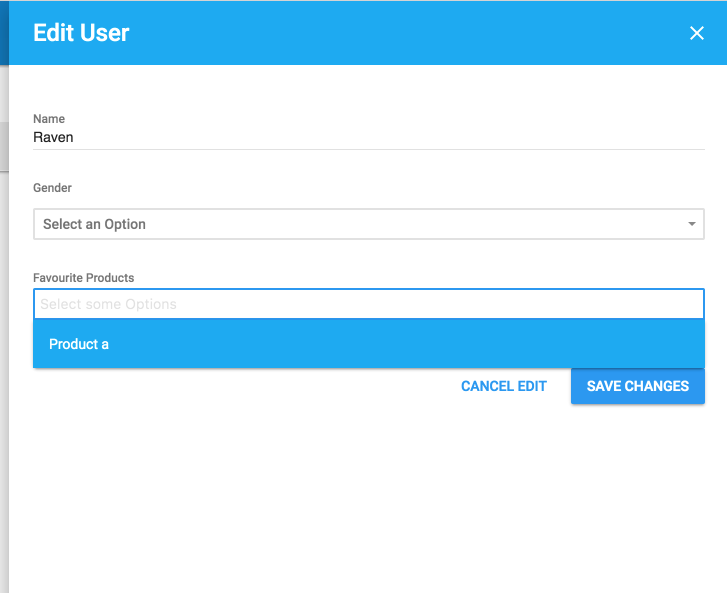Select Many
Configurations
type SelectManyConfig struct {
Collection interface{} // []string, [][]string, func(interface{}, *qor.Context) [][]string, func(interface{}, *admin.Context) [][]string
DefaultCreating bool
Placeholder string
SelectionTemplate string
SelectMode string // select, select_async, bottom_sheet
Select2ResultTemplate template.JS
Select2SelectionTemplate template.JS
RemoteDataResource *Resource
PrimaryField string
}
Collection
Specify the options of the select, accepts type:
[]string[][]stringfunc(interface{}, *qor.Context) [][]stringfunc(interface{}, *admin.Context) [][]string
Placeholder
Select option's placeholder
DefaultCreating
by default, select will pop up a list for user to select, if this set to true, it will pop up a new form for creating
SelectionTemplate
SelectionTemplate accept a file path to overwrite default select template, which usually used when writing plugins to customize select one's template.
Refer sortable select many as an example.
SelectMode
Set the data source of the options:
select
Select options with prepare options when loading the page, if you configured
Collection, this is the only allowed optionselect_async
Select options with remote data from
RemoteDataResourcebottom_sheet
Select options in a popup with remote data from
RemoteDataResource, with the popup, you are allowed to do some advanced work, like creating dataDefaultCreatingonly can works with this mode
Select2ResultTemplate
Same as select2's option templateResult |
Select2SelectionTemplate
Same as select2's option templateSelection
RemoteDataResource
Works in conjunction with theSelectMode configuration, when set to select_async or bottom_sheet the value represents the data resource
select will request remote data as JSON from RemoteDataResource, and use its ID as select option key, use field Name or Title or Code or the first value of JSON as select option value
PrimaryField
If ID is not your primary key for RemoteDataResource, you could customize it with PrimaryField
Examples
Set option manually
Assuming, in a hypothetical project, a User has many favorite brands, like:
type User struct {
gorm.Model
Name string
Gender string
FavouriteBrands []string
}
...So add two hypothetical brands "AwesomeStuff" and "ExcellentStuff" as candidates.
user.Meta(&admin.Meta{Name: "FavouriteBrands", Type: "select_many", Config: &admin.SelectManyConfig{Collection: []string{"AwesomeStuff", "ExcellentStuff"}}})
Use association data
You can use an other resource's data as options. Assuming, in a hypothetical project, a User has some favorite products, and there is a Product called "Product a" existing in the database: QOR can associate these recources automatically, with very little configuration.
type User struct {
gorm.Model
Name string
Gender string
FavouriteProducts []Product
}
type Product struct {
gorm.Model
Name string
Description string
}
user.Meta(&admin.Meta{Name: "FavouriteProducts", Type: "select_many"})
Screenshot:

Overwrite default SelectionTemplate
u.Meta(&admin.Meta{
Name: "FavouriteProducts",
Type: "select_many",
Config: &admin.SelectManyConfig{
Collection: []string{"ASICS", "Lacoste"},
SelectionTemplate: "metas/form/customised_select_many.tmpl",
},
})